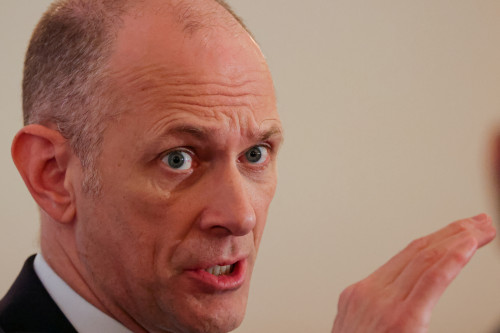By Ann Saphir
(Reuters) -Chicago Federal Reserve Bank President Austan Goolsbee said on Wednesday he is uneasy assuming that tariffs will not push up inflation and is unconvinced that the U.S. labor market is deteriorating.
Those premises have been cited by a few of his colleagues for supporting interest rate cuts by the U.S. central bank.
However, Goolsbee left the door wide open to aligning with them by the Fed’s September 16-17 policy-setting meeting.
“All of the meetings this fall, they are going to be live meetings,” with decisions based on the latest data, Goolsbee told reporters after a speech.
“I’m not implying that I can’t reach a decision by meetings that are coming up, because like I say, we’re going to get some good and important pieces of information that I’m going to add to the ones that we’ve gotten for the last three months.”
If inflation is convincingly falling and the labor market is cooling, “that’s not hard … when things are cooling the Fed tries to act countercyclically,” he said.
The Fed left short-term borrowing costs in the 4.25%-4.50% range at its July 29-30 meeting, drawing dissents from Vice Chair of Supervision Michelle Bowman and Governor Christopher Waller who wanted to cut rates to head off what they worried was incipient labor market weakness.
To Goolsbee, the signs are more mixed.
While monthly job gains, after recent revisions, slowed sharply in the last three months to an average of 35,000, the drop could very well reflect a decline in immigration rather than an underlying weakening in demand, he said.
Other data like the unemployment rate of 4.2% and low layoff rate suggest the labor market remains solid, he said.
Goolsbee also said he needs to see multiple months of good inflation readings to feel comfortable about a rate cut.
“I envision we’re going to keep learning information and keep going on the path; the more convincing it is that we are on path to 2% inflation, the faster I think we can go to what is r-star,” he added, using an economists’ term for the level at which interest rates should settle when the economy is running neither too hot or cold.
“You could cut, one, in anticipation if you think you’re on the path, as long as you’re laying out the criteria of what you’re doing … and if we start getting information that contradicts that then we would stop cutting or go the other way: that’s an entirely possible path, outcome, or whatever you want to call it,” he said.
“The way I think of it is not a cliff – it’s not, I’m going to reach an epiphany one day,” he said, and cut rates immediately to where they are expected to settle in the long term, which Fed policymakers generally estimate is around 3%.
(Reporting by Ann Saphir; Editing by Andrea Ricci and Richard Chang)

